Ducks, often seen as serene and placid creatures, harbor a fascinating secret in their sleep behavior. One questions that often is asked is, do ducks sleep with one eye open?
Yes, ducks often sleep with one eye open, a behavior known as unihemispheric slow-wave sleep. This allows one hemisphere of their brain to remain alert for predators while the other rests. It’s a survival mechanism particularly observed in ducks on the periphery of a group for enhanced vigilance.
This article delves into the intriguing world of how ducks sleep, particularly focusing on the phenomenon of sleeping with one eye open.
This unique behavior, a blend of alertness and rest, offers a window into the complex survival strategies of these birds and provides insights that extend beyond the avian world.
Understanding Unihemispheric Slow-Wave Sleep (USWS)
Unihemispheric Slow-Wave Sleep (USWS) is a sleep state where one hemisphere of the brain remains awake while the other is in a deep sleep.
This phenomenon is particularly evident in aquatic birds like ducks. It allows them to keep an eye open for potential threats while still getting the rest they need.
In ducks, this behavior is a critical adaptation for survival, enabling them to be vigilant even in a vulnerable state.
Scientific Studies on Ducks Sleeping with One Eye Open
Numerous studies have explored this unique aspect of duck behavior. One notable research project observed a row of mallards sleeping. It was found that ducks positioned at the ends of the row, who were more vulnerable to predators, predominantly slept with their outer eye open.
This contrasted with those in the middle, who displayed no particular preference.
Table: Overview of Major Studies and Their Findings
| Study | Focus | Key Findings |
|---|---|---|
| Study on Mallards | Eye preference in sleeping | Ducks at row ends keep outer eye open more often |
| Comparative Study | USWS in birds and mammals | Similarities in sleep patterns across species |
| Behavioral Analysis | Impact of position in flock | Position in flock influences sleep behavior |
The Role of Predation in Duck Sleep Patterns
The primary driver behind ducks sleeping with one eye open is the threat of predation. This behavior allows ducks to detect approaching predators while still resting.
This phenomenon is not unique to ducks; it’s observed in other bird species and even some mammals, indicating a widespread evolutionary strategy for survival.
How Ducks Alternate Sleep Modes for Safety (100 words)
Ducks have a remarkable ability to alternate between full sleep and USWS. This alternation is influenced by their position within the group.
Ducks on the periphery are more likely to engage in USWS, while those in the center enjoy deeper, more restful sleep. This rotation ensures that all members of the group stay alert and rested.
List: Steps in the Duck Sleep Cycle
- Peripheral ducks engage in USWS.
- Central ducks experience full sleep.
- Periodic rotation of positions within the group.
Implications for Understanding Human Sleep
The study of ducks’ sleep patterns offers intriguing parallels to human sleep disorders. For instance, phenomena like sleepwalking may be linked to partial brain wakefulness during sleep.
These insights pave the way for a deeper understanding of sleep mechanisms in humans and could influence the treatment of sleep-related disorders.
FAQs About Ducks and Sleep
- Do all ducks sleep with one eye open?
- Typically, ducks on the periphery of a group are more likely to sleep with one eye open.
- Is this behavior unique to ducks?
- No, similar behaviors are observed in other birds and some mammals.
- Does sleeping with one eye open affect the quality of a duck’s sleep?
- Ducks in USWS may not rest as deeply as those in full sleep, but they still manage to balance rest with vigilance.
Conclusion: Broader Implications of Duck Sleep Studies
The exploration of how ducks sleep with one eye open not only unravels a mystery in avian behavior but also contributes to the broader understanding of sleep as a biological function.
These studies highlight the complexity of sleep mechanisms across species and open up new avenues for research in both animal behavior and human sleep disorders.
As we continue to explore these fascinating aspects of sleep, we may uncover more about the intricate balance between rest and alertness in the animal kingdom.

